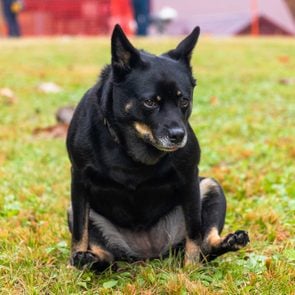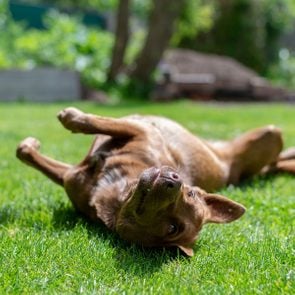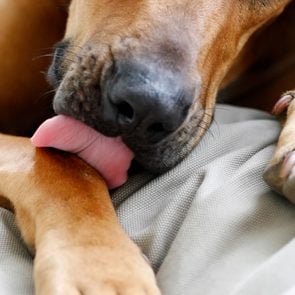How to Clean Your Dog’s Teeth Easily and Effectively
Updated: Apr. 03, 2024
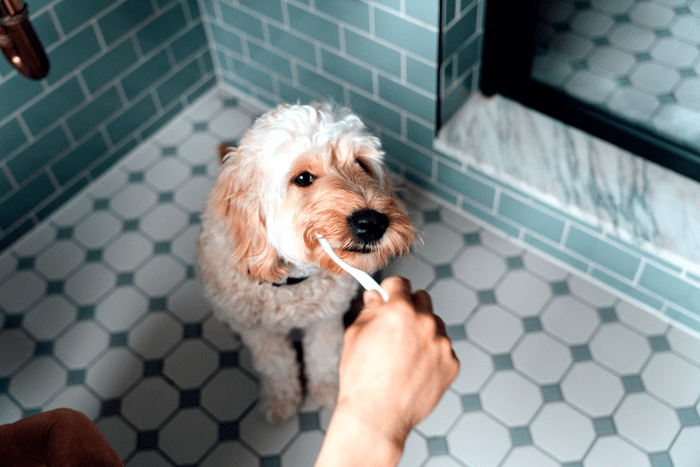
Nearly all dogs develop dental problems and stinky breath. Learn how to clean your dog's teeth and improve their oral health with these vet-approved tips.
Learning how to clean your dog’s teeth helps prevent bad breath and tooth pain. But just because dogs won’t naturally open wide and say “ahh,” doesn’t mean you need to turn to a professional every time their teeth need brushing. At-home dog-teeth cleaning can save you major vet costs and even extend your dog’s life (periodontal disease affects the whole body, after all).
As a certified animal behavior consultant, a Fear Free–certified trainer and author of more than 35 pet-care books, I’ve written about and taught cooperative dog-handling tips for more than 30 years. And like your pets, my dog doesn’t automatically accept invasive handling without lots of preparation. Without training, pups dive under the bed, run away or struggle—even if you know how to groom your dog. And the process can break your heart—nobody wants their dogs to be scared.
But never fear. With the help of board-certified veterinary dentist Naomi Hoyer, DVM, I’ve created the ultimate guide to cleaning your dog’s teeth. With the doggy dental tips and tricks below, you can ensure your pup’s teeth get clean. My pets come running for tooth care now—and yours can too.
Get Reader’s Digest’s Read Up newsletter for more pets, humor, travel, tech and fun facts all week long.
About the experts
Reviewed for accuracy by: Wailani Sung, MS, PhD, DVM, DACVB, a board-certified veterinarian and veterinary behaviorist who is the owner of Bay Area Vet Behavior. |
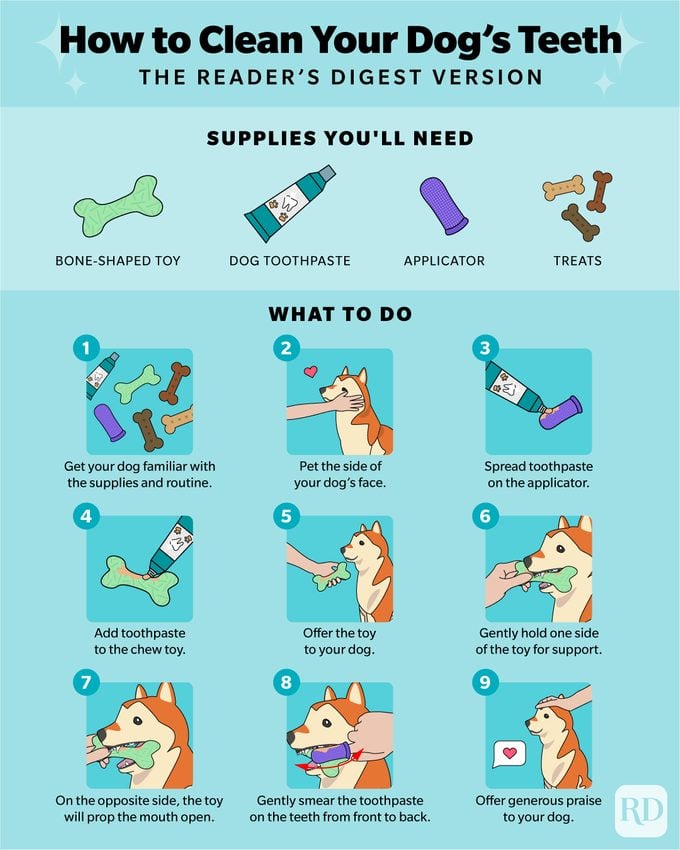
Why is it so important to brush your dog’s teeth?
According to Dr. Hoyer, learning how to clean your dog’s teeth is the best way to control plaque accumulation and prevent dental disease. “Plaque mixes with the minerals in saliva and is known as calculus [tartar] and then is very challenging to remove from teeth.”
And because tartar (the yellow or brown spots you notice on your pup’s teeth) impacts whole-body health, brushing teeth is necessary to prevent additional problems that could cut your dog’s life short. The same bacteria found in a dog’s mouth with dental disease is often implicated in endocarditis, an inflammatory heart disease, according to VCA Animal Hospital experts. The liver and kidneys also are affected by oral bacteria, because these organs filter bad stuff out of the blood.
“Dental disease is the most common disease in our small animal patients (both dogs and cats),” says Dr. Hoyer. “Greater than 70% of dogs more than 3 years of age have some form of dental disease. All dogs, no matter the breed can develop dental disease.”
Besides tooth loss and painful chewing, you may notice a variety of dog illness symptoms in pups with dental disease, including fever, weight loss and loss of appetite.
Also Check: Sweet puppy breath is a fleeting joy. But what causes it and how long can you expect it to stick around?
How often should you brush your dog’s teeth?
Ideally, you should brush your dog’s teeth daily, says Dr. Hoyer. But when you have a busy schedule like I do, it proves challenging to brush a dog’s teeth after every visit to the food bowl. “If the goal is to reduce calculus (mineralized plaque), then you need to brush at least three times per week,” says Dr. Hoyer. Even a couple of times a week improves a dog’s oral health—any amount of dog-teeth cleaning works better than doing nothing at all.
Start brushing your dog’s teeth as a puppy. Youngsters more easily accept tooth brushing as normal—they don’t know any better, and their smaller size makes them easier to manage. Adult dogs may object to the intrusion, but they still can learn to accept tooth care. Cleaning your dog’s teeth is part of grooming and is as important as giving your dog a bath.
How to get your dog comfortable with teeth cleaning
You already know how to brush your own teeth, and the same technique actually applies to cleaning your dog’s teeth. But a vital part of cleaning a dog’s teeth includes teaching them what to expect, so they won’t feel scared. Remember: Teaching any dog takes time. Don’t rush or force your pet. It may take three days or three weeks before a dog will let you clean its teeth. Once a dog understands and accepts the procedure, the teeth cleaning won’t take more than a few minutes. Before you even bring out the toothbrush, take time to train your dog on its new teeth-cleaning routine. Here’s how to get your dog comfortable with teeth cleaning.
Step 1: Schedule training
Dogs love routine, so cleaning your pet’s teeth in the same location and at the time each day can help your furry friend view teeth cleaning as part of a normal day.
Step 2: Signal tooth time with a towel
Until your dog learns to accept you brushing its teeth, things can get messy. A towel helps contain any mess and also lets your dog know what to expect. That can comfort a shy or fearful dog too. For a small dog, spread the towel on your lap. This helps you control the interaction better, as it will feel similar to a snuggle session. For big dogs, lay the towel on the floor and kneel next to your pup, with the dog between your knees, facing out.
Step 3: Touch your dog’s mouth
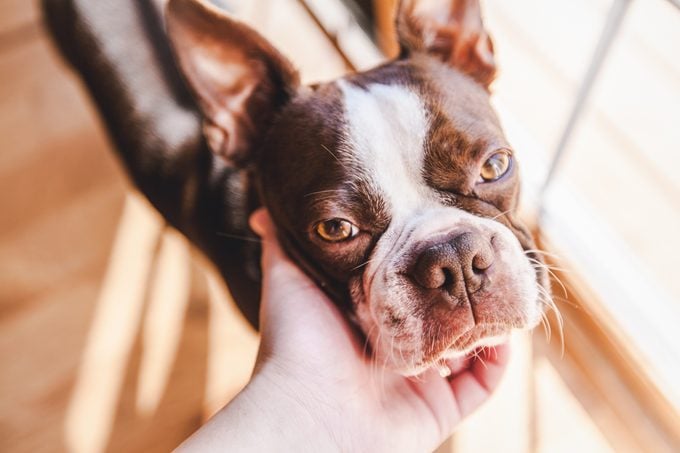
Start by petting the side of your pup’s face, paying particular attention to the outside of their mouth and lips. If you feel comfortable, allow mouthing, which is when a dog puts its teeth and mouth over a person’s skin while using little or no pressure from the jaws. This way, you can easily touch the outsides of the dog’s teeth. Do this for five minutes and offer a treat each time your dog lets you stroke their gums or touch a tooth. Repeat this step once or twice a day for three to five days. After the dog accepts your handling of its mouth, move on to using toothpaste.
Step 4: Teach with a tasty toy bone
Spread dog toothpaste on a non-fabric toy, such as a rubber chew bone. Choose a large chew bone that the dog can comfortably grasp. (It should also be big enough to extend out each side of the mouth and keep the jaw slightly open.) Let your pup lick off the paste—many dogs enjoy flavored pet toothpaste like a treat. Canine toothpaste includes ingredients that help clean teeth even without brushing, so that’s a great first step. You want to associate the toy with the yummy flavor.
Step 5: Offer a toothpaste-coated toy bone
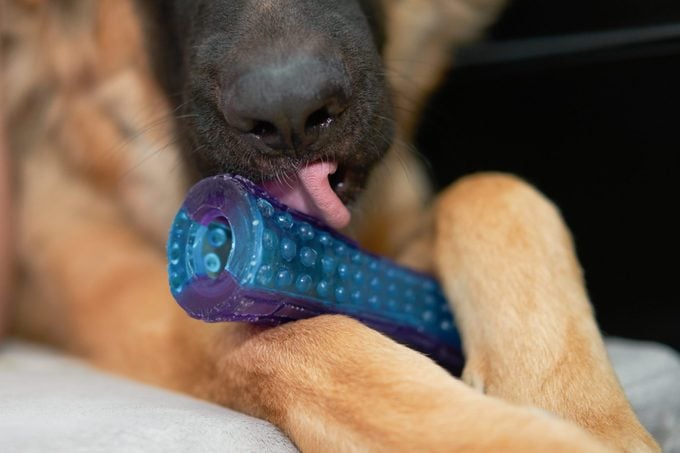
If your dog wants to take the toy into its mouth, that’s great! As the dog takes the toy, say, “Open.” That teaches the cue word and essentially trains the dog to open wide on its own, so there’s no need for scary unproductive wrestling. Eventually, you’ll only need to say the word to prompt the dog to take the toy.
Step 6: Gently hold one side of the toy for support
When your dog has the bone in its mount, hold one side of the toy steady and in place with one hand. That way, the flavored toy props the mouth slightly open enough to offer a gap in which to begin brushing with the other hand. Never squeeze the dog’s muzzle. And keep in mind that dogs are sensitive about toys in their mouth, which makes this an important training step. Ideally, once trained, your dog will know to take the flavored toy into its mouth and allow you to gently hold the toy steady to administer the toothpaste.
Step 7: Get your dog comfortable with the toy routine
Reserve this special toy for teeth cleaning so your pet only gets the yummy paste and other treats for this purpose—they’ll look forward to the fun. When you start out, spend about five minutes playing with the toy, taking it from your dog to add paste. Say, “Open,” to cue your dog to take the toy. Say, “Drop it,” for a release. Praise after each time and reward with a treat. Repeat this step once or twice a day for several days in a row.
Step 8: Introduce the applicator
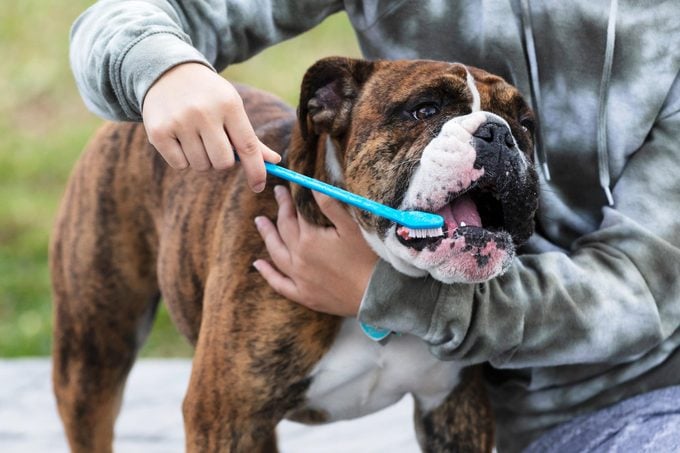
Once your dog accepts the above steps, introduce the applicator of your choice. You must feel comfortable using it or your dog will sense your stress and feel equally uneasy. You can do this! Choose a finger toothbrush, doggy toothbrush or gauze-wrapped finger. Let them sniff your application of choice first. Then add the toothpaste. While holding the toy bone propped inside the dog’s mouth with one hand, use your other hand to slip the toothpaste-loaded applicator inside the dog’s lips. Leave it only a few seconds, then remove and release the dog’s toy bone as you say, “Drop it.” Used consistently, your dog will learn to drop it when you ask.
Step 9: Praise your dog
Give extravagant praise as your dog licks their lips. And congratulate yourself, too. Follow up immediately with a favorite treat or game to reward your dog’s extraordinary intelligence and tolerance. Once your dog acts excited at the sight of the towel, toy and paste, you can move on to routine dog-teeth cleaning.
How to clean your dog’s teeth
I recommend training your dog to accept the process well before you start brushing the teeth. Set aside at least a couple of weeks for preparation and training. Dogs can’t learn when scared, so strive to make the experience pleasant with lots of rewards (treats, cuddling, praise, games—whatever your dog loves). Even the best-natured dogs may growl or snarl when they don’t understand what you want, feel scared or are accidentally hurt. Stop immediately if this happens! That growl or snarl warns you to stop, so feel grateful that dogs communicate with us—and listen to them.
It’s best to begin brushing a dog’s teeth before problems develop. For adult dogs, have your veterinarian provide a professional cleaning first, if needed, so you can maintain the healthy start. Otherwise, dogs won’t want you touching sore, painful gums. I also highly recommend using the rubber bone or toy prop because it gives your dog something to chomp besides your fingers and prevents an accidental bite, which can do major damage.
And pro tip: Don’t touch inside the mouth (behind the teeth). Because the tongue keeps the inside surface of the teeth clean, you only need to clean the outside surface, so don’t risk fingers poking inside the mouth!
Supplies you’ll need
Bring everything you plan to use to the location you’ll be cleaning your dog’s teeth. You may want to keep teeth-cleaning tools in the same place as your other grooming supplies. Your pup should eventually enjoy the experience and expect the event. To speed up the process, choose somewhere your dog already associates with fun times or yummy rewards, like in the kitchen near the food bowl.
- Chew toy: A rubber bone-shaped dental toy works great, sized large enough so that the ends stick out of the dog’s mouth on each side when held. Dental toys usually have nubs that help clean teeth as the dog chews or that hold dog toothpaste.
- Bath towel: A towel provides an easy-to-clean surface for training and eventual teeth cleaning. Using the same towel each time signals to your dog what happens next.
- Dog toothpaste: Never use human toothpaste with your dog. Dogs can’t spit and shouldn’t swallow the fluoride that human products contain. Dogs also hate the foaming action. Don’t use baking soda, either, as the high alkalinity can upset canine tummies when swallowed. Instead, choose a toothpaste designed specifically for dogs. Pet toothpaste comes in flavors that dogs love, like chicken.
- Applicator: Choose a tool you feel most comfortable using. A dog toothbrush, finger toothbrush that slips over your finger or a disposable gauze pad that slips over your finger all work well to spread the toothpaste.
- Bonus rewards: Dogs liked getting “paid” for being good, just like humans enjoy a bonus for a job well done. If your dog loves treats, offer dental treats after the session. Or if a play session or car ride prompt bigger wags, “pay” your dog with the preferred reward.
Step 1: Prepare the applicator with toothpaste
Whether you’re using a finger toothbrush, gauze pad or dog toothbrush, you’ll want to spread dog toothpaste onto the brushing material. You won’t need a lot of paste, so just add enough to cover the end of your finger.
Step 2: Add toothpaste to the rubber chew toy
Spread dog toothpaste on your chosen chew toy. Since you’ve already taught your dog what the yummy-flavored dog toy means, this signals to them that more treats will come.
Step 3: Offer the rubber chew toy
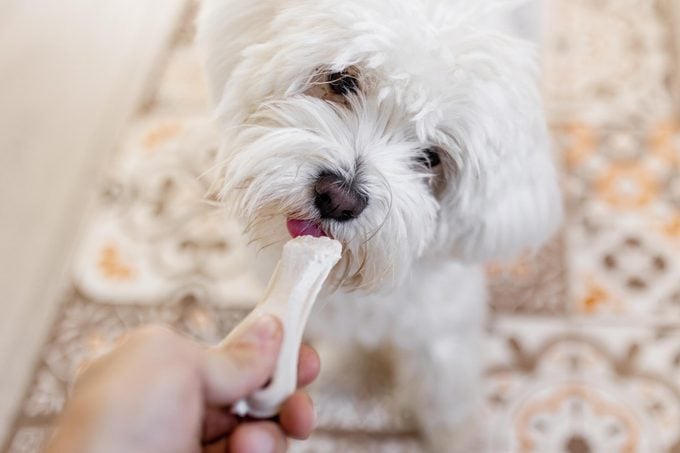
Gently stroke your dog’s face and muzzle in preparation for inserting the toy bone. Say, “Open,” and praise when the dog grasps the toothpaste-covered toy.
Step 4: Hold the toy in place
As your dog closes its mouth around the toy, hold it in place with one hand. Avoid squeezing the muzzle. Your hand should support rather than restrain the dog in this position. For small dogs, it can help to kneel on the floor with your pup between your knees, facing out, so they can’t wiggle away. Holding the toothpaste-coated toy in place should offer a gap in which to begin brushing.
Step 5: Clean one side of the teeth first
With one hand wrapped around the opposite side of the dog’s toy, use the toothpaste-covered applicator to wipe the outside of the dog’s teeth on one side of its mouth. Do the top jaw first, and if your dog is still fine with it, finish with the bottom teeth on the same side. You don’t need to scrub—simply wipe the paste from side to side. Start out with a brief front-to-back (or back-to-front) smear of paste on the sides of the teeth, whichever feels most comfortable for you. Then release and remove the toy. The dog will lick lips and savor the paste you’ve left on the teeth. When you’re first starting out, be satisfied with one side and a quick smear. Then quit for the day.
Step 6: Clean the other side of the teeth
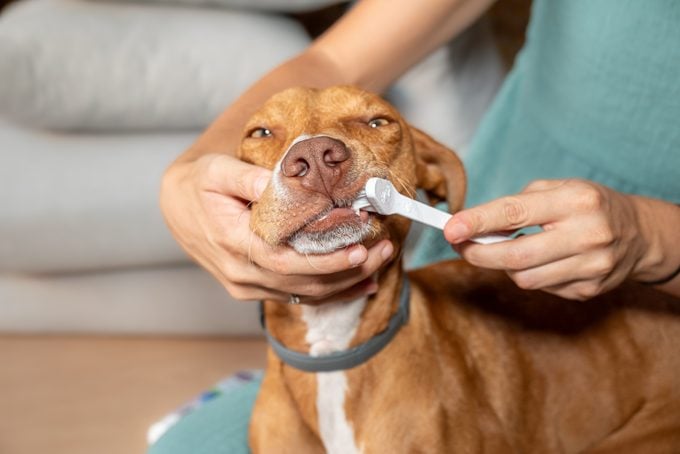
The next day, repeat the previous steps. This time, you’ll clean the teeth on the other side of your dog’s mouth. Remember, there’s no need to clean the inside of the teeth since the dog’s tongue keeps those surfaces clean. Just wipe the outside of the teeth. As your dog builds up tolerance, and you become more comfortable, you can spend more time gently rubbing the teeth back and forth. Again, you’re not scrubbing hard. You want the process to feel gentle and safe.
Step 7: Offer generous praise
Always quit before your dog asks you to stop; it’ll leave your pup wanting more. Then offer praise to your happy dog and treat generously.
Step 8: Move on to cleaning both sides
After two weeks of alternating one-sided teeth cleanings, your dog should understand the process. Hopefully, it also looks forward to this teeth-cleaning routine. Now it’s time to graduate to cleaning all of the teeth at once. This shouldn’t take more than five minutes, including preparation time. If possible, brush daily.
What else keeps a dog’s teeth clean?
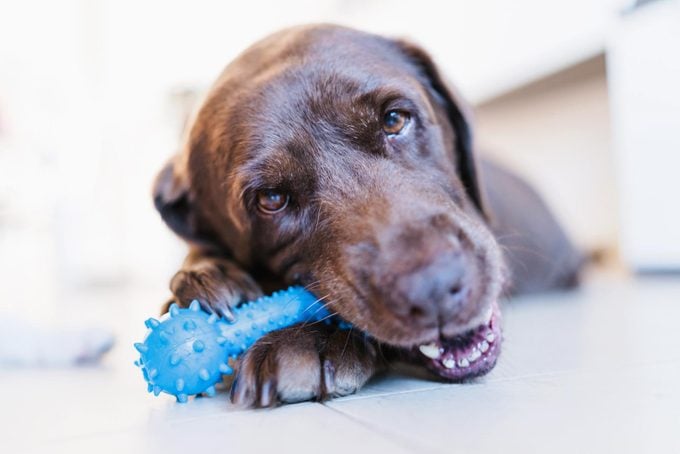
Let’s face it, some dogs refuse to put up with teeth-brushing no matter how slowly and well you train. It’s not worth risking a bite or damaging the relationship you have with your dog. While brushing is ideal, rather than force the issue, there are other ways that help keep your dog’s teeth clean. “If brushing isn’t an option, then other modalities, such as dental diets and dental chews, can be used,” says Dr. Hoyer. “But they aren’t as good as brushing.” Here are some options.
- Dental food: Dogs evolved to gulp and gorge, not to chew. The detergent action of scrubbing teeth by chewing up healthy treats, such as apples and carrots, can help but not as much as we’d like. Thankfully, today we have special foods designed to help reduce or prevent the formation of tartar and plaque. The Veterinary Oral Health Council endorses certain supplements, rinses, pastes and treats that have met this criteria. Look for products that include the VOHC seal of approval and ask your veterinarian for a recommendation.
- Chew toys: Dogs love to chew. Besides the edible chews and treats recommended by VOHC, a wide array of dental chew toys are available. From rope-type dog toys to rubber chews with dental-scrubbing nubs, you can find nearly any size and configuration to fit your tiny-to-giant dog’s mouth. These work by scrubbing the teeth as the dog gnaws. You can improve the effectiveness by adding a dental treat that prolongs the chewing and offers enzymatic or other benefits that address tartar.
- Dental treats: We love to treat our dogs anyway, and offering treats with the VOHC seal ensures we’re helping and not adding to our dog’s dental issues. One of my favorites, Greenies, works great and comes in a variety of sizes and shapes for any size dog. My dog and cats adore Greenies and line up with eager wags and purrs to get their daily treats.
- Dental rinse: There are products you can use to rinse off your dog’s teeth after brushing the teeth. Some you just add to your dog’s water to help keep its teeth clean. They can also help with pungent breath issues.
Do you also have to get your dog’s teeth cleaned professionally?
In a word, yes, says Dr. Hoyer. “Comprehensive anesthetized dental procedures are important, because even if an owner is able to brush every day, there are areas that are impossible to clean unless a patient is anesthetized.” General practice veterinarians are a critical part of providing dental care, and many can perform extractions and other surgical procedures. She says a comprehensive professional veterinary dental procedure includes:
- Pre-anesthetic evaluation (usually including blood work)
- Anesthetized oral examination
- Full-mouth intraoral radiographs (X-rays)
- Cleaning and polishing of all teeth
- Treatment of any identified oral pathology
Dr. Hoyer says monitoring anesthetized pet patients is important. “In dogs, we often don’t know what is actually going on with their oral cavity until after we get the radiographs, which can only be performed in anesthetized patients.”
The general practice veterinarian may not perform specialized procedures like root canals, or want to treat a high-risk anesthesia patient, and instead may refer you to a veterinary dental specialist. Never hesitate to request a referral if you feel more comfortable with a specialist caring for your special pet. “Quality dentistry care is often expensive care,” she says, and it varies so much based on where you live. Call your local veterinarian for a general ballpark, but be aware that the cost may increase depending on what the doctor sees during the procedure.
She suggests asking these questions so you understand the costs involved and what to expect:
- Will the person monitoring my pet’s anesthesia also be performing the dental cleaning?
- What anesthetic monitoring techniques are used?
- Are full-mouth radiographs obtained for every procedure?
- Are the radiographs reviewed by a veterinarian?
- Who performs the anesthetized oral examination?
- What are the plans if my animal develops an anesthetic complication?
- If my pet needs extractions, how will I be informed, and who will perform them?
In most cases, damaged or decayed teeth get removed, not repaired. That’s why brushing your dog’s teeth not only improves their health but also saves you pocketbook pain. You can reduce the frequency of required professional cleanings by learning how to clean your dog’s teeth at home.
Signs of dental disease in dogs
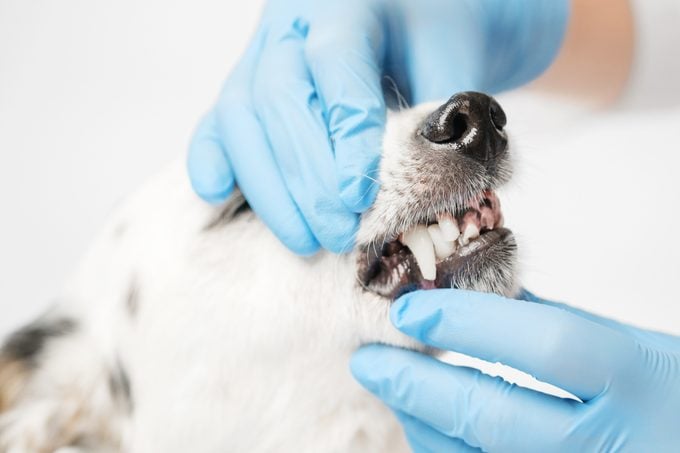
Unfortunately, you probably won’t notice dog dental problems until they become advanced. “Often, pets don’t show any signs of periodontal disease, but things to look for at home include bad breath, red and bleeding gums, changes in eating behaviors and signs of pain around the mouth,” says Dr. Hoyer. Other warning signs may include:
- Broken teeth: Dogs that chew hard objects like rocks, sticks or hard toys may break off or loosen teeth.
- Yellow to brown plaque: One of the most noticeable signs of periodontal disease is a buildup of gross-looking hard deposits at the base of the dog’s teeth.
- Discolored teeth: A discolored tooth could indicate the death of the tooth root or a crack in the enamel. That can cause great pain.
- Facial swelling: Just as with people, an abscessed tooth can cause swelling of the jaw.
- Blood on a toy: You might never notice the dog’s bleeding gums until blood stains a toy.
- Irritability: A classic sign of dog dental issues is a gradual change in behavior. Happy dogs become snappy; energetic dogs may sleep more and become reluctant to play. Once teeth problems resolve with treatment, dog owners often are amazed at how they act like a puppies again.
FAQs
What softens tartar on a dog’s teeth?
Tartar is a film that grows on teeth. It can be dissolved with some of the dental diet and treat formulations (and dog toothpaste) that help prevent it sticking to the teeth or forming in the first place. A dental chew toy can help mechanically remove tartar film, as can brushing the dog’s teeth.
Should I scrape the plaque off my dog’s teeth?
No. Any kind of tool capable of mechanically scraping away plaque could also slip and injure your dog. Plaque also extends below the gum line, and you can’t access that while your dog remains awake.
What is the best natural way to clean a dog’s teeth?
The best way to naturally clean a dog’s teeth is to provide healthy and safe chew options, brush the dog’s teeth and provide a dental diet and/or treats that help prevent tartar buildup.
Is it too late to start brushing my dog’s teeth?
No. While puppies often accept new things more readily, with patience, dogs of any age can learn to accept home dental care.
Why trust us
At Reader’s Digest, we’re committed to producing high-quality content by writers with expertise and experience in their field in consultation with relevant, qualified experts. For this piece, dog exert Amy Shojai, CABC, tapped 30 years of experience teaching and writing about pet behavior, and then Wailani Sung, MS, PhD, DVM, DACVB, a board-certified veterinary behaviorist in San Francisco, gave it a rigorous review to ensure that all information is accurate and offers the best possible advice to readers. For this piece, we relied on reputable primary sources, including a veterinarian and certified dog behaviorists. We verified all facts and data and backed them with credible sourcing, and we will revisit them over time to ensure they remain accurate and up to date. Read more about our team, our contributors and our editorial policies.
Sources:
- Naomi Hoyer, DVM, DAVDC, board-certified veterinary dentist; email interview, Feb. 20, 2024
- VCA Animal Hospitals: “Dental Disease and Its Relation to Systemic Disease in Pets”
- The Veterinary Oral Health Council: “VOHC Accepted Products”
- American Veterinary Dental College: “Mission and Objectives”
- Cornell Richard P. Riney Canine Health Center: “Periodontal Disease”


